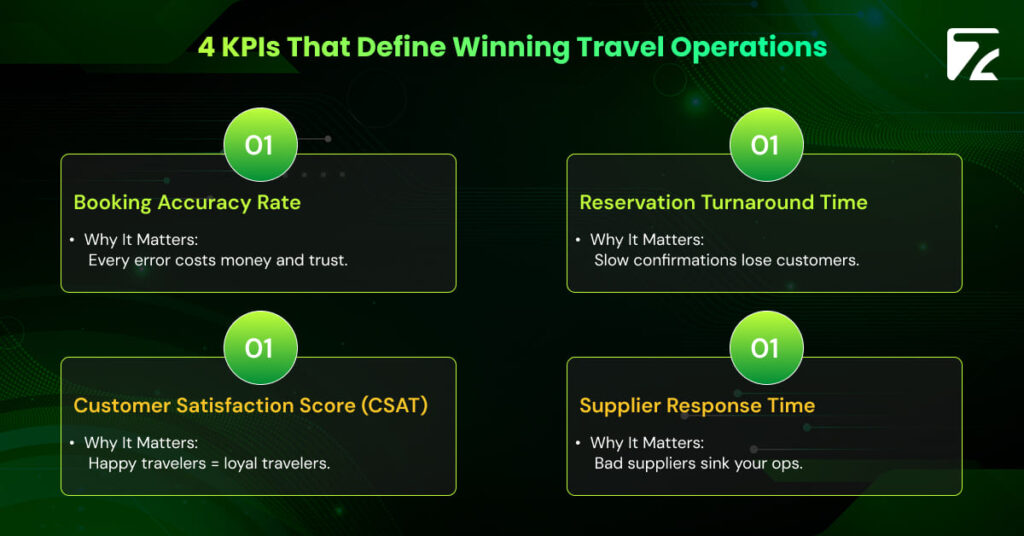In travel operations, success isn’t about how fast you can book a ticket.
It’s about how well you control chaos.
Every day, operations teams deal with shifting supplier inventories, panicked last-minute cancellations, travelers who expect Amazon-speed service, and corporate clients who demand SLA perfection at rock-bottom margins.
You can’t manage this kind of pressure with gut feelings.
You manage it with KPIs the only defense against operational entropy.
The goal here isn’t to impress you with a neat KPI checklist.
It’s to show you what really matters in the field and why ignoring these metrics is the fastest way to kill your travel business from the inside.

KPIs in travel operations aren’t just performance numbers.
They’re early warning systems.
If you’re watching them right, they tell you where your processes are breaking before your customers notice.
If you’re watching the wrong ones or worse, not watching at all you’re essentially piloting a 747 blindfolded.
In manufacturing, if something breaks, you can replace a part.
In travel?
If a hotel overbooks, if a refund takes 14 days instead of 3, if a misbooked itinerary ruins a client’s conference trip the damage is reputational, permanent, and almost always expensive.
KPIs aren’t decoration. They are survival metrics.
Show me your KPIs, and I’ll show you where your company is bleeding money, losing clients, and creating enemies among your own agents without realizing it.
Companies that live inside their KPIs grow smarter, faster, leaner.
The rest… blame the market, suppliers, pandemics anything but themselves.
Choosing KPIs without understanding your business model is like buying tires without knowing what car you drive.
If you’re a B2B TMC, your KPIs must scream SLA compliance, policy adherence, traveler satisfaction.
If you’re a B2C OTA, you better be obsessed with CSAT, Booking Accuracy, and refund speed.
If you’re a luxury DMC, your KPIs had better track Supplier Reliability and Customization Success Rate.
If your KPIs aren’t actionable daily, they’re just vanity metrics.
Travel operations are live environments.
A missed KPI today Booking Accuracy drops to 96% turns into client escalation tomorrow and churn next quarter.
If your KPI dashboard updates once a month, you’re already too late.
Let’s be blunt:
Every operational disaster starts with the wrong booking.
One wrong digit in a flight time? One missed hotel policy?
Suddenly, it’s 3 AM in Sydney and your emergency team is scrambling for a fix while burning $1,200 in rebook fees.
Booking Accuracy Rate = Accurate Bookings / Total Bookings x 100
Anything lower, you’re bleeding refunds and rework.
Speed isn’t a luxury anymore it’s a requirement.
Travelers expect confirmations in minutes, not hours.
| Travel Type | Turnaround Expectation |
|---|---|
| Domestic Air | 5–10 minutes |
| Hotels | 10–20 minutes |
| International Complex Trips | 30–60 minutes |
If your backend systems are batching supplier responses every 4 hours, you’re already losing 15–20% of impatient B2B customers.
Ask after service: “How satisfied were you with your interaction?”
High CSAT doesn’t just look good.
It saves accounts.
Especially when a big client’s CFO starts looking for reasons to RFP you out.
Industry average: 83–85%
Real target: Above 90% if you want loyalty.
One interaction. One solution.
Every time a traveler has to call back, two bad things happen:
Here’s the trap:
Push too hard to lower AHT, and agents start rushing travelers off the phone without solving anything.
Travelers expect cancellations.
What they don’t expect and won’t tolerate is chasing you for refunds weeks later.
Brands who refund faster retain 22% more customers after negative trips (Statista, 2024).
If a traveler’s problem lingers beyond 48 hours, it festers.
You can’t fix silence with discounts. Speed is your only repair tool.
When suppliers drag, so do your confirmations.
And travelers blame you, not your backend chain.
| Supplier Type | Max Acceptable SLA |
|---|---|
| Airlines | 2 hours |
| Hotels | 4 hours |
| Ground Transport | 6 hours |
Good ops teams monitor supplier response time live, not at quarter-end.
High revenue means nothing if operational drag kills your margins.
World-class ops cost per booking:
If you’re sitting at $35–$50 per booking, your ops aren’t just slow they’re eating your profits.
Revenue-per-agent tracks more than sales it tracks operational momentum.
If it’s stagnant, you’re overstaffed, poorly trained, or cross-sell blind.
High RPA correlates with:
If travelers won’t recommend you, they won’t stay with you either.
| NPS Range | Meaning |
|---|---|
| 30–40 | Danger Zone |
| 50–60 | Healthy Growth |
| 70+ | Market Leaders |
Without consistent 60+ NPS, you’re always vulnerable to the next cheaper TMC or shinier OTA.
Manual ops kill scaling.
| Automation Scope | Impact |
|---|---|
| <30% automation | Slow, error-prone ops |
| 50–70% automation | Resilient, agile ops |
Smart automation isn’t about firing agents.
It’s about freeing your best people from stupid, repeatable tasks.
Corporate travel contracts live and die by SLA performance.
Targets:
Miss SLA consistently? You’ll be RFP’d out faster than you can say “Service Level.”
Unmanaged traveler behavior bleeds client budgets and your reputation.
The best TMCs maintain 90–95% policy compliance through automated booking nudges and dynamic traveler education.
One rogue traveler can blow a quarter’s savings.
It all adds up.
No excuses.
Travel operations is a war fought in minutes and margins.
If you aren’t measuring the right KPIs and fixing what they reveal ruthlessly you’re just waiting for problems to catch you unprepared.
In this business, you don’t rise by moving faster.
You rise by moving smarter armed with real data, disciplined action, and a relentless refusal to let operational cracks widen into gaping holes.
Travel is unforgiving.
Your KPIs are your armor. Wear them well or get out of the way.
Booking Accuracy Rate, Reservation Turnaround Time, Customer Satisfaction (CSAT), First Contact Resolution Rate (FCR), and Cost Per Booking.
Use booking validation systems, provide agent training, and audit supplier feeds regularly.
Higher FCR reduces customer complaints, operational costs, and improves loyalty.
Simple issues: 6–8 minutes.
Complex itineraries: 10–15 minutes.
Higher CSAT boosts repeat bookings and client retention, leading to stronger long-term profitability.

Travel Automation Expert